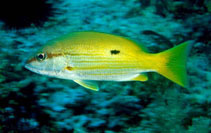
|
Lutjanus fulviflamma (Forsskål, 1775) Dory snapper |

|
|
photo by
Field, R. |
| Family: | Lutjanidae (Snappers), subfamily: Lutjaninae | |||
| Max. size: | 50 cm TL (male/unsexed); max. reported age: 23 years | |||
| Environment: | reef-associated; brackish; marine; depth range 3 - 35 m | |||
| Distribution: | Indo-Pacific: Red Sea (Ref. 4320), Persian Gulf (Ref. 94051) and East Africa to Samoa, north to the Ryukyu Islands, south to Australia. | |||
| Diagnosis: |
Dorsal spines (total): 10-10; Dorsal soft rays (total): 12-14; Anal spines: 3-3; Anal soft rays: 8-8. This species is distinguished by the following characters: body moderately deep; greatest depth 2.6-2.9 in SL; preopercular notch and knob poorly developed; vomerine tooth patch triangular or diamond-shaped, with a medial posterior extension; gill rakers of first gill arch 6-7 + 9-12 (including rudiments) = 16-19; caudal fin truncate to slightly emarginate; scale rows on back rising obliquely above lateral line. Colour of back and upper sides brown, lower sides whitish or light brown and belly whitish to yellow, usually a series of 6-7 yellow stripes on the sides and a prominent black spot at level of lateral line, below base of anterior part of soft portion of dorsal fin (Ref. 9821, 90102).
Description: Dorsal profile of head moderately sloped; preorbital bone about equal in width to eye diameter or slightly less; tongue with a patch of granular teeth. |
|||
| Biology: | Adults inhabit coral reefs (Ref. 30573, 58652), usually in schools on coastal reefs and in deep lagoons (Ref. 48635). Often in large aggregations with Lutjanus kasmira and Lutjanus lutjanus (Ref. 9710). Juveniles are sometimes found in mangrove estuaries or in the lower reaches of freshwater streams. Feed mainly on fishes, shrimps, crabs and other crustaceans (Ref. 30573). Caught mainly with handlines, traps, and gill nets. A small species, commonly utilized in subsistence fisheries but also seen frequently in markets where it is sold usually fresh (Ref. 9821). Neither anterolateral glandular groove nor venom gland is present (Ref. 57406, information in the table as dangerous fish, does not match; needs verification). | |||
| IUCN Red List Status: | Least Concern (LC); Date assessed: 04 March 2015 Ref. (130435) | |||
| Threat to humans: | reports of ciguatera poisoning | |||